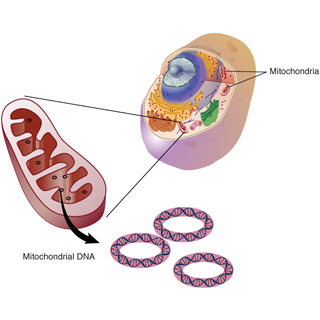
Mitochondria produce 90% of a cell's energy, and also contain their own genomes in the form of a double-stranded circular molecule known as mitochondrial DNA (mtDNA). (Courtesy: National Human Genome Research Institute)
Instructor(s)
Dr. Daniel Ferullo
MIT Course Number
7.342
As Taught In
Spring 2011
Level
Undergraduate
Course Description
Course Description
The primary role of mitochondria is to produce 90% of a cell's energy in the form of ATP through a process called oxidative phosphorylation. A variety of clinical disorders have been shown to include "mitochondrial dysfunction," which loosely refers to defective oxidative phosphorylation and usually coincides with the occurrence of excess Reactive Oxygen Species (ROS) production, placing cells under oxidative stress. A known cause and effect of oxidative stress is damage to and mutation of mitochondrial DNA. We will use this class to explore issues relating to mitochondrial DNA integrity and how it can be damaged, repaired, mutated, and compromised in human diseases.
This course is one of many Advanced Undergraduate Seminars offered by the Biology Department at MIT. These seminars are tailored for students with an interest in using primary research literature to discuss and learn about current biological research in a highly interactive setting. Many instructors of the Advanced Undergraduate Seminars are postdoctoral scientists with a strong interest in teaching.


